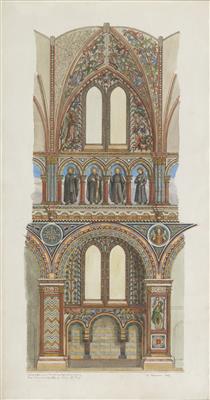Theophil Melicher

(Vienna 1860–1926) Pair of designs for the sacred furnishing of Viennese churches, one sheet inscribed and signed Th. Melicher 1893 (?), “Entwurf für eine Kirchenpolychromierung der Canisiuskirche Wien IX. Bezirk” (design for the polychroming of Saint Canisius in Vienna, 9th district), the second sheet unsigned, watercolour and black ink on paper, 31 x 60 cm and 24 x 64 cm, framed, (2)
Provenance:
Private Collection, Austria The two sketches are designs for the polychroming of the nave of Vienna’s Saint Canisius Church, which was erected by Gustav Ritter von Neumann between 1899 and 1903 and was remodeled by Ladislaus Hruska in 1956. Except for a few parts, the original equipment of the church has not survived.
The second sheet was executed for the “Weinhauserkirche” in Vienna-Währing, which was erected after plans by Friedrich von Schmidt, the architect and master builder of Saint-Stephen’s Cathedral. It shows the shields of coat of arms with the monograms of Christ and Mary and above them a canopy architecture, which represents a scene where, surrounded by two squires, the Roman-German Emperor Leopold I is handing over the task of Vienna’s defense to the commander in chief Count Rüdiger v. Starhemberg, Archbishop Leopold Karl Kollonitsch and to others. Kahlenberg with the monastery of Saint Joseph and the fortress and chapel of Leopoldsberg where the decisive battle against the Turks had taken place on the occasion of the second siege of Vienna through the Ottoman troops is seen in the windows in the background. The Viennese Guardian Angel, who is kneeling and commending the town’s coat of arms as a symbol for Vienna to the Holy Trinity, is seen in the scene above. The quatrefoil with a cross in its center and the inscription “In hoc signo vinces” in the tracery allude to the victory of Emperor Constantin at the Milvian Bridge in 312. The design with its religious and political implications was part of an extended cycle of glass windows for the intended church of St. Joseph in Weinhaus, which should thus serve as a monument. Instead of this cycle, however, the windows were painted after designs by Rudolf Geyling, which were executed in 1889 and are still existent today.
Literature:
Werner Telesko: Das “Türkengedächtnis” im Wiener Kirchenbau, in: Kulturraum Österreich, Vienna, Cologne, Weimar, 2008, p. 39.
We are grateful to Alicia Ysabel Spengler for her scientific support in cataloguing the two present designs.
Expert: Mag. Astrid-Christina Schierz
 Mag. Astrid-Christina Schierz
Mag. Astrid-Christina Schierz
+43-1-515 60-546
astrid.schierz@dorotheum.at
02.03.2017 - 16:00
- Odhadní cena:
-
EUR 900,- do EUR 1.200,-
Theophil Melicher
(Vienna 1860–1926) Pair of designs for the sacred furnishing of Viennese churches, one sheet inscribed and signed Th. Melicher 1893 (?), “Entwurf für eine Kirchenpolychromierung der Canisiuskirche Wien IX. Bezirk” (design for the polychroming of Saint Canisius in Vienna, 9th district), the second sheet unsigned, watercolour and black ink on paper, 31 x 60 cm and 24 x 64 cm, framed, (2)
Provenance:
Private Collection, Austria The two sketches are designs for the polychroming of the nave of Vienna’s Saint Canisius Church, which was erected by Gustav Ritter von Neumann between 1899 and 1903 and was remodeled by Ladislaus Hruska in 1956. Except for a few parts, the original equipment of the church has not survived.
The second sheet was executed for the “Weinhauserkirche” in Vienna-Währing, which was erected after plans by Friedrich von Schmidt, the architect and master builder of Saint-Stephen’s Cathedral. It shows the shields of coat of arms with the monograms of Christ and Mary and above them a canopy architecture, which represents a scene where, surrounded by two squires, the Roman-German Emperor Leopold I is handing over the task of Vienna’s defense to the commander in chief Count Rüdiger v. Starhemberg, Archbishop Leopold Karl Kollonitsch and to others. Kahlenberg with the monastery of Saint Joseph and the fortress and chapel of Leopoldsberg where the decisive battle against the Turks had taken place on the occasion of the second siege of Vienna through the Ottoman troops is seen in the windows in the background. The Viennese Guardian Angel, who is kneeling and commending the town’s coat of arms as a symbol for Vienna to the Holy Trinity, is seen in the scene above. The quatrefoil with a cross in its center and the inscription “In hoc signo vinces” in the tracery allude to the victory of Emperor Constantin at the Milvian Bridge in 312. The design with its religious and political implications was part of an extended cycle of glass windows for the intended church of St. Joseph in Weinhaus, which should thus serve as a monument. Instead of this cycle, however, the windows were painted after designs by Rudolf Geyling, which were executed in 1889 and are still existent today.
Literature:
Werner Telesko: Das “Türkengedächtnis” im Wiener Kirchenbau, in: Kulturraum Österreich, Vienna, Cologne, Weimar, 2008, p. 39.
We are grateful to Alicia Ysabel Spengler for her scientific support in cataloguing the two present designs.
Expert: Mag. Astrid-Christina Schierz
 Mag. Astrid-Christina Schierz
Mag. Astrid-Christina Schierz
+43-1-515 60-546
astrid.schierz@dorotheum.at
|
Horká linka kupujících
Po-Pá: 9.00 - 18.00
kundendienst@dorotheum.at +43 1 515 60 200 |
| Aukce: | Selected by Hohenlohe |
| Typ aukce: | Salónní aukce |
| Datum: | 02.03.2017 - 16:00 |
| Místo konání aukce: | Wien | Palais Dorotheum |
| Prohlídka: | 23.02. - 02.03.2017 |
Všechny objekty umělce
